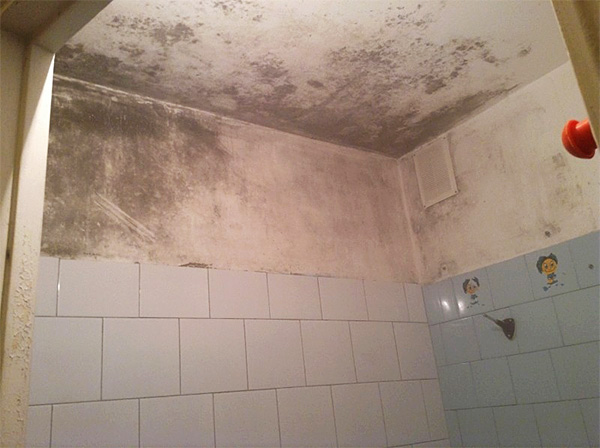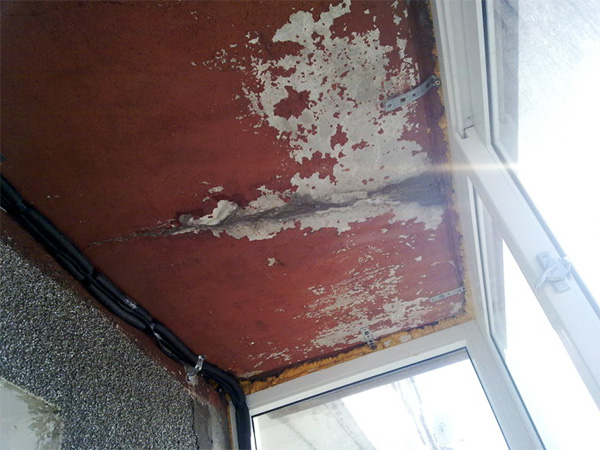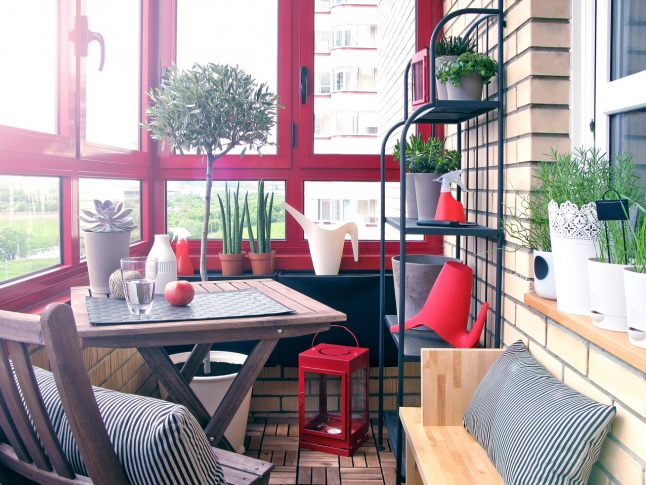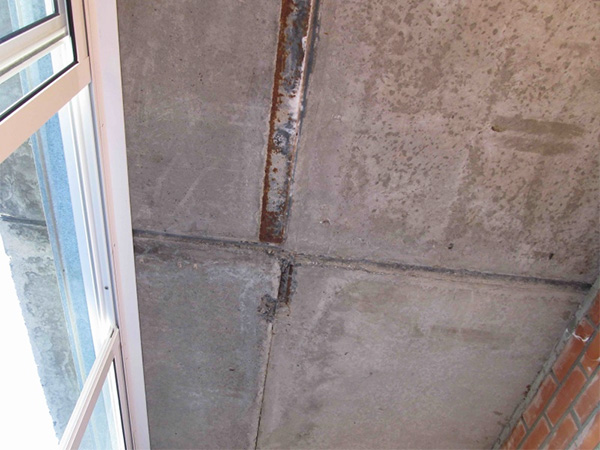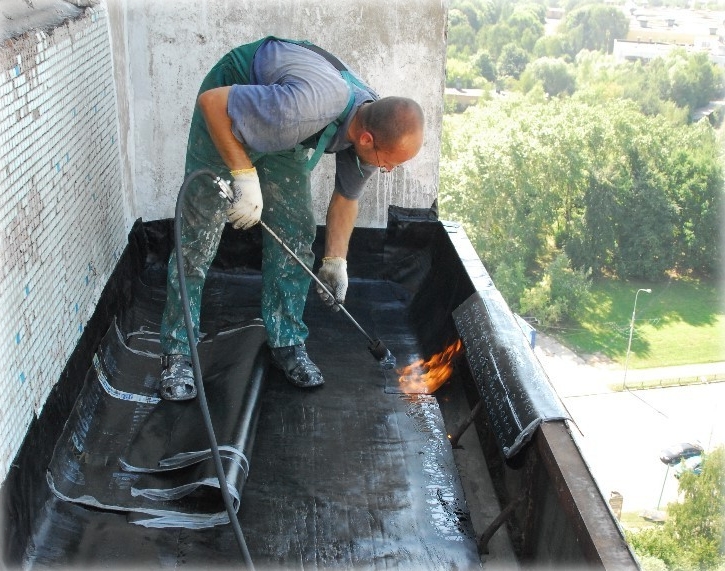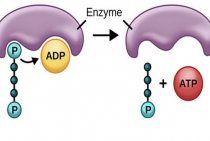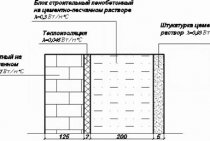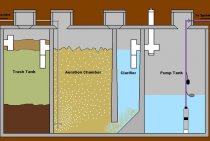How to properly waterproof the ceiling in the bathroom
Let's first raise our eyes up, look at this very ceiling and answer the question: where and why do leaks most often occur? Where is it flooding us?
Exactly. You are absolutely right.
Always flows exclusively at the seams! Along the same seams along which concrete slabs are joined. And even if it seems to you that it is dripping all over the plane of the ceiling, the water comes exactly at the seams! It rarely seeps through the entire plane of the concrete slab. Although, of course, it happens.
It follows that task number 1 is to seal all the seams!
In order to tell you in detail how this is done, we have written a standard technical solution. Let's break down the process step by step.
I stage. Surface preparation.
1. Along the seam / joint of concrete structures (ceiling / wall, ceiling / ceiling), clean the adjacent concrete surface from finishing materials, dust, dirt, laitance, efflorescence and anything that can reduce the adhesion of materials to the surface (at least 5 cm.
on both sides of the joint).2. Make a U-shaped strobe at the seam / junction of concrete structures to a depth of at least 2.5 cm and a width of at least 2.5 cm, clean and rinse the strobe and the adjacent area.
II stage. Joint sealing.
1. Moisten the concrete with a brush, remove excess water. 2. Apply coating waterproofing to the surface of the strobe and the adjacent area (5 cm on both sides of the strobe): Bastion GO2K - if the structure “breathes” (cracking is possible), Bastion Tr - if the time for performing work is limited, in other cases - Bastion GO. The solution is applied with a hard brush in one layer.
Layer thickness – not less than 1.2 mm. Seal and smooth the surface of the solution. 4. After 1-2 days, apply on the surface of the strobe and the adjacent area (5 cm each on both sides of the strobe) one layer of coating waterproofing Bastion GO2K / Tr / GO (similar to item 2).
As you can see, everything is quite simple and can be done by any specialist who has the skills to work with cement mixtures or plaster materials. Therefore, you can, if you wish, try to do this work yourself. Or still hire specialists, but already fully understanding what they should do and how much it will cost.
Features of applying waterproofing
Each waterproofing material has its own application specifics. Even ready-made compositions and materials require special surface preparation and following the technology of applying and drying.
In the course of preparatory work, the old coating should be removed from the ceiling and adjacent walls, and the cleaned surface should be thoroughly degreased and dusted.
The presence of contaminants will be a significant obstacle to the adhesion of any type of waterproofing material.
Particular attention should be paid to the seams: if possible, the joints of the plates are also carefully cleaned, grooved to a depth and width of up to 2.5 cm, and then treated with a sealant. Upon completion of the drying process of the general layer of waterproofing, the strobe is filled with a repair solution, after a day the final layer of the moisture-proofing agent used is applied to the entire surface of the ceiling.
If the concrete slab is affected by mold, it should be thoroughly cleaned and treated with special antifungal primers, after which the ceiling must be dried.
Some materials require a pre-coating of the ceiling surface with a primer, others (for example, penetrating waterproofing) require good wetting of the concrete, and others require thorough drying.
If you use penetrating waterproofing to protect the ceiling from moisture, the active powder should be diluted with water in the ratio indicated by the manufacturer on the container. Polymer compounds and bitumen-rubber mastics can be immediately applied to the ceiling in the bathroom.
When applying coating materials or using penetrating waterproofing, the manufacturer's recommendations for the thickness of the layers and their drying time should be strictly observed. It is impossible to start re-processing if the composition has not had time to seize, while it is important not to “overexpose” the materials - an overly hardened composition will lose the necessary adhesion.
Most formulations require spraying after the final coat has been applied. Such measures, taken during the day, will allow a single waterproofing layer to dry slowly and evenly, without forming cracks.
How to waterproof the ceiling in the apartment - read the following review.
Ceiling waterproofing methods
To date, a number of materials are used for waterproofing ceilings in rooms. They differ in cost, service life, method of application. Therefore, before finally making a choice, you need to learn more about each of the options in order to choose the most suitable one. Let's talk briefly about each of them.
Bituminous and polymer coating waterproofing
This type of material is used relatively rarely in residential premises - more often it is used for external waterproofing. First of all, because of its appearance - it has a rich black color, which is quite difficult to disguise with paint, whitewash or wallpaper. But still, it will be useful to have an idea about bituminous waterproofing.
 Bituminous waterproofing
Bituminous waterproofing
It is a homogeneous mixture consisting of a bituminous binder, special herbicides, antiseptics and filler. Precisely verified composition allows it to have a number of important advantages:
- Durability.
- Ease of application.
- Ability to work at both low and high temperatures.
- Resistant to high humidity.
It stretches well and has excellent self-healing performance.
It is important that bituminous materials have high adhesion, that is, they can be applied to almost any surface.
But still, if you are interested in waterproofing a concrete ceiling in an apartment, it cannot be called the best choice. Although, when working on loggias and balconies, it is used quite often. For interior spaces, it is better to give preference to more suitable analogues.
Waterproof cement-polymer plaster
This is a special dry mix, which includes cement and special polymer additives. On sale you can see two types of cement-polymer plaster - both are great for waterproofing the ceiling in an apartment.
 Dry mix for cement-polymer waterproofing
Dry mix for cement-polymer waterproofing
One-component formulations contain all the necessary additives. Working with it is quite simple - just dilute it with water until a suitable consistency is obtained, after which you can start working.
Two-component waterproofing is usually supplied in separate packages. The first is a dry mix, and the second is special emulsions and water-protective additives. By mixing these components, the user receives a high-quality waterproofing composition.
Externally, the cement-polymer material resembles ordinary plaster. It is applied to the surface using the same tools. However, when working, you can notice that it has a more elastic structure. Thanks to this, the material is easily applied to any surface - both vertical and horizontal, after which they perfectly cope with the task - protecting the room from moisture.
When applied, the mastic bonds securely to the surface to be treated, creating a waterproof barrier on it. An important advantage can be called the ability to "breathe" - the plaster absorbs excess moisture from the room, and when the humidity level drops, it gives it back. Thanks to this, it creates the most comfortable microclimate in the room.
The only drawback of this option is the high cost.But if you are interested in waterproofing the ceiling in the bathroom, then a relatively small amount of material will be required, so the overspending of several hundred rubles is fully justified.
Penetrating waterproofing
If you need to ensure reliable blocking from moisture in the shortest possible time, then experts recommend using penetrating waterproofing. It includes components such as:
- cement,
- sand,
- modifiers (chemically active additives).
It is enough to add the right amount of water to the mixture so that the additives are activated. After that, the active phase will last no more than half an hour. During this time, you need to have time to use the entire solution. It is for this reason that waterproofing penetrating mixtures are prepared immediately before use.
When penetrating ceiling waterproofing is applied to a concrete surface, the composition quickly spreads through the pores and capillaries. When the mixture dries, crystals are formed that cannot be dissolved with water. Thanks to them, water will not be able to penetrate the concrete structure.
How much does bathroom ceiling waterproofing cost?
What is the cost of waterproofing the ceiling in the bathroom? Of course, from the cost of work and the cost of materials. Let's find out more about both.
So.
common data
For waterproofing 1 linear meter of the ceiling seam in the bathroom, we need:
1.1 kg of BASTION PP+ repair mortar
and
0.6 kg of any coating waterproofing. Or two-component coating waterproofing Bastion GO2K, or Bastion TR or rigid coating waterproofing Bastion GO.
About what kind of waterproofing to use in each case, it is best to consult.
For example, now we will make a calculation using the Bastion GO2K material. You can easily replace it with another one. Only the price will change, the cost will remain the same.
So, looking at the price list, we recalculate all this into real money:
1.1 * 48 + 0.6 * 154 rubles = 145.2 rubles
The cost of waterproofing the seam is 600 rubles / linear meter. meter.
In other words, the cost of waterproofing 1 running meter of a seam in the bathroom will be about 750 rubles.
Thus, in order to get an estimated cost for waterproofing the ceiling in your bathroom, there is very little left for you to do. Take the length of all the seams in your bathroom and multiply by 750.
Why indicative? Yes, because we will get the exact amount of materials only when we calculate it as a multiple of the package.
Container volume:
Bastion GO Bag 25 kg. Bastion RR + Bag 25 kg. Bank 6 kg. Bank 6 kg. Bastion GO2K Set 9 kg. + 3 kg.TrBank Bastion 5 kg.
Please pay attention!
Estimated material consumption does not take into account possible losses, errors in determining the volume and area of processing. It is recommended to purchase 10% more than the calculated quantity.
Please observe the instructions in the current technical description.
Well, now for a specific example.
For example, if you have a bathroom measuring 2 * 3.5 meters, and in the middle of the ceiling there is another joint between the plates 2 meters long, then we will get the amount we need by adding 2 +2 +2 +3.5 +3.5 = 13 meters.
Materials for waterproofing a seam in such a bathroom are necessary:
Repair mortar BASTION PP+: 13*1.1 = 14.3 kg. Or 1 pack of 25 kg for 1200 rubles
and any type of coating waterproofing 13 * 0.6 \u003d 7.8 kg. In this case, the options are:
or 2 packs of Bastion TR 5 kg each for 2 * 864 = 1728 rubles
or 1 pack of 25 kg Bastion GO for 1574 rubles
or 1 set 12 kg Bastion GO2K for 1843 rubles
Total materials in the amount of 2774 to 3043 rubles.
If you decide to order the whole complex of works on a turnkey basis, and receive an additional guarantee not only for materials, but also for the final result, then the work will cost 600 * 13 = 7,800 rubles.
In any case, the choice is yours. After all, now you can do it consciously and skillfully. Well, if you have any questions, just give us a call and we will be happy to answer them.
The question of the need for waterproofing the ceiling in the bathroom is increasingly being faced by apartment owners.
What problems does water ingress protection help to solve and what materials are considered the most effective and reliable? The need for waterproofing the ceiling in the bathroom Such situations often arise due to the use of flexible hoses when connecting a washing machine to a water supply and sewerage system, worn out pipes in old buildings, poor-quality plastic welding, and simply due to carelessness. Even slight leaks from the upper neighbors, if you do not have waterproofing, can lead to the need to update the repairs made.
What materials will really help protect the ceiling from moisture? Express waterproofing It is convenient to divide waterproofing agents of various composition into categories according to the method of application to the ceiling surface. The most popular and effective are gluing and coating materials, among the latter are the so-called. penetrating waterproofing, which is today a recognized leader in its segment.
Bathroom waterproofing
Waterproofing a bathroom in an apartment is something that needs to be given special attention, because
it is a source of potential water production. The waterproofing of the bathroom is carried out according to the same scenario - waterproofing the floor in the bathroom, walls and ceiling of the apartment with Penetron penetrating compound. Ensuring watertightness throughout the entire thickness of the concrete floor, walls and ceiling, as well as sealing the joints of the "wall-floor", "wall-ceiling" junctions.
For individual solutions and questions on the waterproofing of an apartment, use the Send a request form or call the phone in Moscow (499) 110-60-10 (multichannel) (495) 928-47-12 (round-the-clock)
The bathroom, as you know, is more exposed to moisture than other rooms in the apartment. From wet feet, the floor gets wet, puddles form near sinks, bathtubs or showers. Water also accumulates on the walls in the form of condensate.
Among other things, this room is a zone of increased risk of accidents and leaks of plumbing and sewerage equipment, improperly connected washing machines, and simple inattention when filling containers with water. That is why the waterproofing of the bathroom (especially in a wooden house) is not only a forced, but also an extremely necessary measure.
The procedure for protecting the premises from moisture should be given due attention.
What you need to know when ordering work on the installation of waterproofing the ceiling in the bathroom to specialists
There are several standard questions for this case:
- What kind of materials will be used? Specify the specific type and brand.
- What experience of working with this material do the masters have. How many similar objects have been made?
- What guarantee does the company provide?
- And, of course, the cost of work. Serious companies immediately name the final cost of the work. Of course, at first it may be preliminary, but after examining the object, everything becomes clear to the ruble. The price must be announced to you BEFORE work begins. And the more clear you will be, from what and how this price is made up, the better!
Having received the answer to these questions, you can easily decide whether you need to deal specifically with this company, or is it better to look for another one? Or even try to do it on your own.
The process of work on the insulation and waterproofing of the ceiling on the loggia
The ceiling of the balcony with waterproofing will be reliably protected from the penetration of moisture and liquid from the outside, provided that all materials are used correctly.
The ceiling of the balcony, the waterproofing of which is carried out by the owners of the apartment themselves, will be reliably protected from the penetration of moisture and liquid from the outside, provided that all materials are used correctly. The sequence of work can be as follows:
If there are gaps, be sure to close them with insulating material.
It is best to use building sealants sold in special tubes to perform this task. Using such a tube, we fill the gaps with sealant and wait for it to completely solidify. This composition will reliably protect against the penetration of moisture through cracks in concrete slabs, between them, as well as between ceiling slabs and walls. Waterproofing the loggia balcony will be most effective when using a special penetrating composition.
It is important to use it correctly. It is best to use this product in spring or autumn, as it should not be cold or hot when it dries. After applying a solution of a penetrating waterproofing composition to the surface of the slab, it is necessary to ensure its long-term (about 3 days) drying
If the plate dries out faster, it will need to be sprayed with water.
After prolonged drying, the penetrating composition will create such a crystalline structure inside the concrete slab that will reliably protect the ceiling of the balcony from getting wet for many decades. as foil isolone. Waterproofing with its help will be brought to perfection, and its fastening to the ceiling can be carried out by any convenient means: with glue, with fastening to a wooden frame or frame with brackets, etc.
The hydroisolon is cut with ordinary scissors. In the case of limited waterproofing with sealants and penetrating material, it will be very convenient to glue to the ceiling with building glue such a universal insulation material as sheets of extruded polystyrene foam. They are convenient in that you can pick up different thicknesses of the sheet, cut out any desired shape and simply glue it to the ceiling concrete slab. In addition, polystyrene foam sheets create a minimum of inconvenience later, when the ceiling cladding material is installed.
Thus, modern materials used for waterproofing make it possible to very simply, quickly and, at the same time, reliably protect the balcony ceiling and the entire balcony space from moisture penetration and unwanted dampness. Thanks to this, balconies and loggias turn into full-fledged living spaces of modern apartments that can be used for various purposes.
https://youtube.com/watch?v=FKAc2uiX2c8rel%3D0%26controls%3D0%26showinfo%3D0
- www.promalpservice.ru
- balkon-fasad-spb.ru
- penetron.ru
- dekormyhome.ru
General information
Bathroom waterproofing materials must protect the entire space
But special attention must be paid to areas in which the effect of moisture is most intense. These include spaces at the sink, shower, around the bath
Also, the protective layer must be laid at the joints of the walls and the floor, the passage of pipes and branches from them, taps, mixers. At the same time, do not forget about the ceiling. As you know, hot steam is lighter than cold, so it rises.
With the unsatisfactory operation of the ventilation system, mold and stains from the emerging condensate begin to form on the ceiling. However, the main load falls on the floor. This is because the water that forms on various surfaces invariably flows down.
What materials are better to use for ceiling waterproofing and why
As a matter of fact, there are really not so many options.
You can use either some polymer-bitumen mastics or polymer-cement materials. We strongly recommend that you focus on polymer-cement materials, since they have a number of significant advantages. Namely:
- Excellent adhesion (adhesion) to the existing ceiling surface provides the most reliable waterproof coating
- High water resistance of the treated surface.
- At the same time, the materials are vapor-permeable, which allows walls and ceilings to dry naturally.
- The applied materials are just as easy to paint as the “basic” ceiling. This is the same cement mortar with the same properties.
- The application of cement materials does not require special equipment and special skills.
- The tool used can be easily cleaned with water.
- Materials can be applied to wet surfaces.
- The same physical characteristics of the materials and the substrate do not lead to the formation of voids.
- The guaranteed service life of materials is more than 15 years.
Let us once again pay attention to the main advantage of polymer-cement waterproofing materials. As the name implies, they are based on a cement mortar with various polymer-cement fillers.
And when we apply this solution to the existing concrete base of the ceiling and walls, the resulting coating is, as it were, an extension of the existing coating. Indeed, can there be anything stronger and more reliable than the connection of concrete to concrete? Of course not! And the delamination of the waterproofing layer from the base, which is almost inevitable over time when using bituminous mastics, is simply excluded in this case! Because we end up with just one more part of the concrete base.
Only differing in addition waterproofing properties. In other words, impervious to water. And the reliability and strength of such a coating can only be rejoiced at.
It is not surprising that there are practically no worthy alternatives to polymer cement materials for waterproofing the ceiling in bathrooms.
Materials used
In order for all work to be completed quickly, efficiently and reliably, it is necessary to select the most suitable materials for a particular situation. The following is a standard list of materials for waterproofing and insulation work on the loggia.
Such a list can be changed taking into account the complexity of the task due to the presence, for example, of large gaps, gaps between ceiling concrete slabs, etc. So, it is advisable to use the following set of materials:
sealant (silicone, acrylic, bituminous, polyurethane) for sealing gaps; Such sealants are very convenient to use and reliable. Of course, the gaps can be both plastered and filled with mounting foam, but it is most convenient and reliable to use sealants. Moreover, many of them will not be needed due to the fact that the area of \u200b\u200bthe balcony and ceiling is not so large; the penetrating composition for waterproofing concrete is reliable a way to make a loggia ceiling slab 100% waterproof.
After applying such a composition, the waterproofing of the ceiling becomes as effective as possible; foil isolone is a material that will perform both the function of an additional waterproofing barrier and a heater; sheets of extruded polystyrene foam are an excellent material for thermal insulation of small rooms. It is very easy to attach to the ceiling and does not greatly reduce the space of the balcony, which is limited in size; construction glue, a knife, scissors and other tools that can be useful for cutting and attaching the materials listed above. The sealant is applied using special tubes, in which it is sold.
Thus, a small set of materials and tools is needed in order for the waterproofing on the loggia to be done with high quality and reliably with your own hands. In addition, given the small area of \u200b\u200bthe room, not very many such materials are needed, which is why the costs will be negligible.
Polymer-cement mixtures
These materials have recently become more and more popular.They have high adhesion to various surfaces.
Due to the content of polymer fillers, the mixtures are highly hydrophobic. These components block microcracks and pores, preventing the penetration of water. As a rule, polymer-cement compositions are mixed with polymer dispersions or binder emulsions.
As a result, the compositions form plasticine-like liquid pastes that can interact with hard surfaces. Such mixtures are considered universal. They are used for waterproofing not only the floor, but also the walls for different finishes.
When Do You Need Ceiling Waterproofing?
The most important is high-quality waterproofing of the ceiling in the bathroom, but you should also not forget about other rooms, especially those where increased information is observed and the pipeline passes: kitchen, bathroom. Unfortunately, no one can be sure that tomorrow the neighbors will not flood it. Do you live on the top floor? In this case, during a storm, it may well damage the roof, as a result of which rain will flood the attic, from where water can easily penetrate into a residential apartment.
In addition, residents of the upper floors are often worried about the waterproofing of the balcony ceiling - during melting snow or heavy rain it is often flooded. But useful things are often stored on the balcony, which did not find a place in the apartment.
So, what gives high-quality waterproofing of the ceiling in the apartment? Here are some of the main advantages of this solution:
- No mold and fungus. Even a small amount of water spilled by neighbors can cause unaesthetic, and in some cases dangerous (if people who are allergic to spores live in the apartment) divorces.
- Significantly increase the service life of building and finishing materials - in case of flooding from neighbors, you will not have to rush to re-repair.
- Eliminate the danger of a short circuit, which is often observed when water leaks from the upper floors and attic.
Therefore, waterproofing the ceiling in the bathroom and other rooms is not at all an empty whim or a waste of money - it is a matter of safety and the preservation of your property.
Building materials for ceiling waterproofing
- Polymer. They are made on the basis of atactic polypropylene, modified copolymers. Examples: vinyl plastic, polyethylene.
- Not polymeric. Examples: fiberglass, roofing material, only.
The process of installing such hydroprotection is laborious and not economically feasible. Pasting insulation can be self-adhesive or fixed only when heated, which is done with a burner. It is rarely used in modern construction and repair work. However, the waterproofing of the ceiling in the apartment is not limited to the interior space; on the loggia, pasting waterproofing is fully justified.
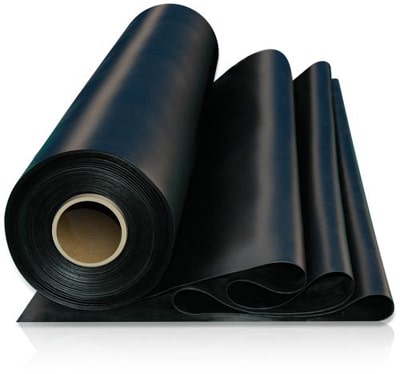
- Bitumen-rubber mastics and bitumen-polymer mastics. Environmentally friendly coating insulation with high elasticity is used for living quarters. It is applied in several layers, which prevents the penetration of moisture. Mastics are used not only on the ceiling, but also on walls and floors, for processing seams, cracks, eliminating leaks on balconies, terraces, in bathtubs, bathrooms, etc.
- Mixtures based on cement with polymer additives.
The composition of coating insulation can be one- and two-component. One-component is ready for use, in two-component it is necessary to add a waterproofing compound before application.

Waterproofing plasters, in addition to the cement-sand component, include waterproof polymers and a complex of functional additives, due to which, after hardening, a surface is formed that prevents the penetration of moisture even under pressure.
As a rule, plaster is used on concrete and brick.
It must be applied on a dry, prepared surface, without microcracks through which water can seep.
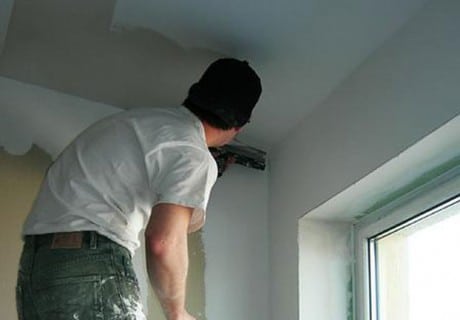
Stretch ceiling can protect against serious flooding from above. Water will accumulate on the film: 1 sq.m. film will withstand 100 liters of water.
Water can be pumped out using special equipment. Stretch ceilings are reliable, but they reduce the height of the room. In addition, the space between the ceiling surface and the film will need to be dried, there is no air circulation, so after pouring, the film may have to be removed.
The advantages of a stretch ceiling include:
- high reliability when pouring;
- perfectly flat surface;
- a small amount of dust and dirt during installation.
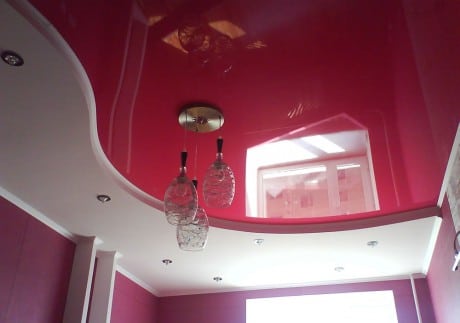
Waterproofing ceilings from the inside in this way is most appropriate in rooms with the greatest risk of flooding: bathrooms, kitchens, bathrooms. Stretch ceilings look good in high rooms, in low ones - they noticeably reduce space due to their design features, so you should consider the appropriateness of their installation from a design point of view.
